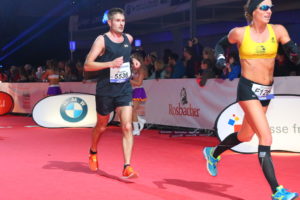 It’s the time of year where many runners who hibernate during the dark and cold Winter months take their first few miles of the year. It’s also the time of the year for Newbies! Perhaps inspiration from a friend or family member, a stress in life is forcing a change, something has sparked the interest in the sport – new runners are testing out their running legs. If you’re new and flirting with the idea of running, or you’re coming back from a serious hiatus, here are some tips and tricks for getting started.
It’s the time of year where many runners who hibernate during the dark and cold Winter months take their first few miles of the year. It’s also the time of the year for Newbies! Perhaps inspiration from a friend or family member, a stress in life is forcing a change, something has sparked the interest in the sport – new runners are testing out their running legs. If you’re new and flirting with the idea of running, or you’re coming back from a serious hiatus, here are some tips and tricks for getting started.
- Check your shoes. If they are over 6 months old, you’ve used them for walks or time in the gym, or they don’t feel supportive or fresh anymore, get a new pair! Your feet are important. There is no “magic” shoe. Just see what feels right to you. Most decent running shoes will run you about $85-150.00.
- Start where you are! It can be humbling for the first run ever, or the first run back after some time off. Aim for 20-30 minutes out there. Maybe it can’t all be a run. Maybe it can. No matter what, go at an easy/moderate effort. It’s important to ease into the sport.
- Avoid cotton socks. Blisters can plague runners, but cotton socks are usually a leading variable. Running socks are a bit more expensive, but worth the investment.
- Lots of runners want to know their data – how far they went, how fast, elevation, calories burned, heart rate, and so on. If that sounds of interest, I’d recommend investing in a running watch. You can find gadgets between $100-700.00 – depending on how high-tech you want to get. There are also a dozen or two apps you can download on your phone. I find the apps to be less accurate, but it’s a cost effective place to start – especially if you don’t know what your relationship with running will be.
- Recruit a running buddy to help with accountability and reduce pressure in speed or distance. Focus on simply making running a consistent part of your life for 3-12 weeks. Run with a furry friend, push the stroller, simply build a habit and allow your body to slowly adapt.
- Don’t compare yourself with anyone else. Your journey with running will be uniquely yours. Your paces, body, mental capacity, preference in route and weather – embrace all of it and own it.
- Set realistic goals and expectations without dismissing your potential. It’s important to accept where we are at that time. For example, signing up for a marathon 18 weeks out from the 1st run of your life or in months is not advisable. But is a marathon 12 months from now? Sure! And can a 5K or 10K be a realistic and attainable goal in 18 weeks? Definitely. The same could be true with setting the goal of running without stopping around Central Park – for example. But can you run to Battery Park from Riverdale? That’s a bigger goal and realistically would take more time. The sky can be the limit, but maybe not by tomorrow.
- If your schedule is stressful, add your runs to your calendar. Make gym dates to stretch, cross train or weight train. If you know you’ll be most successful at consistency if you run before work, plan to always run in the morning and start your day off right. If you thrive on a lunch time run, lace up and get in that afternoon sunshine. Set yourself up for success. Reduce obstacles.
- Accept that your running journey can change and adapt. This doesn’t have to be a serious sport. It can be fun, a stress reliever, or whatever it is you want. It can be a lone experience or a social activity. It can be incredibly competitive and driven. Make it yours!
 Races that go well and exceed every expectation make running feel so incredibly liberating. They are satisfying, empowering and simply fun. It’s these races that usually motivate us to keep signing up and racing.
Races that go well and exceed every expectation make running feel so incredibly liberating. They are satisfying, empowering and simply fun. It’s these races that usually motivate us to keep signing up and racing. Last week I posted about the importance of the off season. Today I want to personally share how I handled my off season, and what lessons I learned about myself as an athlete in my latest marathon cycle, and how I’ll plan to make changes in the future. It’s important to understand that our bodies will adapt and change to anything we toss at it – with time, consistency, and a solid combination of work and recovery. It’s always easier to be the coach than the athlete, and I’ve worn both hats for myself for the last few years. While I know my body and my strengths and weaknesses, it’s not without its challenges.
Last week I posted about the importance of the off season. Today I want to personally share how I handled my off season, and what lessons I learned about myself as an athlete in my latest marathon cycle, and how I’ll plan to make changes in the future. It’s important to understand that our bodies will adapt and change to anything we toss at it – with time, consistency, and a solid combination of work and recovery. It’s always easier to be the coach than the athlete, and I’ve worn both hats for myself for the last few years. While I know my body and my strengths and weaknesses, it’s not without its challenges. The off season. Most runners are really bad at this. It’s incredibly tempting to cross that goal finish line fired up and ready to dive into the next goal. Even if legs feel great within a day or two of that goal race, it’s important to relax and PAUSE. I completely understand that post-marathon high. I clearly remember days after my first marathon, signing up for two spring marathons with all the enthusiasm in the world. We feel invincible, fired up and inspired. PAUSE. Injury risk is incredibly high within the days/weeks following that goal marathon. Even if you FEEL good, trust that there are things that are broken down and rebuilding. Remember that just like the hard work and the taper, a reverse taper is necessary. The best marathoners in the world take an off season. None of us are the exception. How long or dramatic of an off season an athlete needs will vary. But when in doubt, be conservative.
The off season. Most runners are really bad at this. It’s incredibly tempting to cross that goal finish line fired up and ready to dive into the next goal. Even if legs feel great within a day or two of that goal race, it’s important to relax and PAUSE. I completely understand that post-marathon high. I clearly remember days after my first marathon, signing up for two spring marathons with all the enthusiasm in the world. We feel invincible, fired up and inspired. PAUSE. Injury risk is incredibly high within the days/weeks following that goal marathon. Even if you FEEL good, trust that there are things that are broken down and rebuilding. Remember that just like the hard work and the taper, a reverse taper is necessary. The best marathoners in the world take an off season. None of us are the exception. How long or dramatic of an off season an athlete needs will vary. But when in doubt, be conservative. First and foremost, I apologize for neglecting my blog for much of 2017. That’s about to change! Second, it has been an incredible year. I am so humbled and proud of the hard work my roster have brought to the table. It’s an honor to do what I do every day.
First and foremost, I apologize for neglecting my blog for much of 2017. That’s about to change! Second, it has been an incredible year. I am so humbled and proud of the hard work my roster have brought to the table. It’s an honor to do what I do every day. I would absolutely recommend Frankfurt Marathon to anyone looking for a flat and fast marathon. It was a pretty amazing day. And the days following the marathon were really fun. Food and drink is everywhere. If you enjoy baked goods and beer, Germany is for you. Frankfurt is an incredibly friendly city to travelers from all over the globe.
I would absolutely recommend Frankfurt Marathon to anyone looking for a flat and fast marathon. It was a pretty amazing day. And the days following the marathon were really fun. Food and drink is everywhere. If you enjoy baked goods and beer, Germany is for you. Frankfurt is an incredibly friendly city to travelers from all over the globe.


